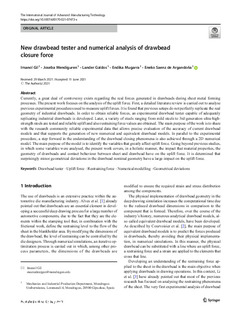| dc.rights.license | Attribution 4.0 International | * |
| dc.contributor.author | Gil, Imanol | |
| dc.contributor.author | Mendiguren, Joseba | |
| dc.contributor.author | GALDOS, Lander | |
| dc.contributor.author | Mugarra Fernandez, Endika | |
| dc.contributor.author | Sáenz de Argandoña, Eneko | |
| dc.date.accessioned | 2021-07-12T11:22:46Z | |
| dc.date.available | 2021-07-12T11:22:46Z | |
| dc.date.issued | 2021 | |
| dc.identifier.issn | 0268-3768 | en |
| dc.identifier.other | https://katalogoa.mondragon.edu/janium-bin/janium_login_opac.pl?find&ficha_no=164336 | en |
| dc.identifier.uri | https://hdl.handle.net/20.500.11984/5341 | |
| dc.description.abstract | Currently, a great deal of controversy exists regarding the real forces generated in drawbeads during sheet metal forming processes. The present work focuses on the analysis of the uplift force. First, a detailed literature review is carried out to analyse previous experimental procedures used to measure uplift forces. It is found that previous setups do not perfectly replicate the real geometry of industrial drawbeads. In order to obtain reliable forces, an experimental drawbead tester capable of adequately replicating industrial drawbeads is developed. Later, a variety of steels ranging from mild steels to 3rd-generation ultra-highstrength steels are tested and reliable uplift and also restraining force values are obtained. The main purpose of the work is to share with the research community reliable experimental data that allows precise evaluation of the accuracy of current drawbead models and that supports the generation of new numerical and equivalent drawbead models. In parallel to the experimental procedure, a step forward in the understanding of the drawbead closing phenomena is also achieved through a 2D numerical model. The main purpose of the model is to identify the variables that greatly affect uplift force. Going beyond previous studies, in which some variables were analysed, the present work covers, in a holistic manner, the impact that material properties, the geometry of drawbeads and contact behaviour between sheet and drawbead have on the uplift force. It is determined that surprisingly minor geometrical deviations in the drawbead nominal geometry have a large impact on the uplift force. | es |
| dc.description.sponsorship | Gobierno de España | es |
| dc.language.iso | eng | en |
| dc.publisher | Springer | en |
| dc.rights | © The Author(s) 2021 | en |
| dc.rights.uri | http://creativecommons.org/licenses/by/4.0/ | * |
| dc.subject | Drawbead tester | en |
| dc.subject | Uplift force | en |
| dc.subject | Restraining force | en |
| dc.subject | Numerical modelling | en |
| dc.subject | Geometrical deviations | en |
| dc.title | New drawbead tester and numerical analysis of drawbeads closure force | en |
| dcterms.accessRights | http://purl.org/coar/access_right/c_abf2 | en |
| dcterms.source | International Journal of Advanced Manufacturing Technology, 2021 | en |
| local.contributor.group | Procesos avanzados de conformación de materiales | es |
| local.description.peerreviewed | true | en |
| local.identifier.doi | https://doi.org/10.1007/s00170-021-07472-x | en |
| local.relation.projectID | GE/Programa Estatal de Investigación, Desarrollo e Innovación Orientada a los Retos de la Sociedad, en el marco del Plan Estatal de Investigación Científica y Técnica y de Innovación 2013-2016/RTC-2015-3643-4/ES/Nueva generación de troqueles más estables y con vida útil prolongada para el conformado de aceros avanzados de alto límite elástico para automoción/HRD | en |
| local.rights.publicationfee | APC | en |
| oaire.format.mimetype | application/pdf | |
| oaire.file | $DSPACE\assetstore | |
| oaire.resourceType | http://purl.org/coar/resource_type/c_6501 | en |
| oaire.version | http://purl.org/coar/version/c_970fb48d4fbd8a85 | en |








